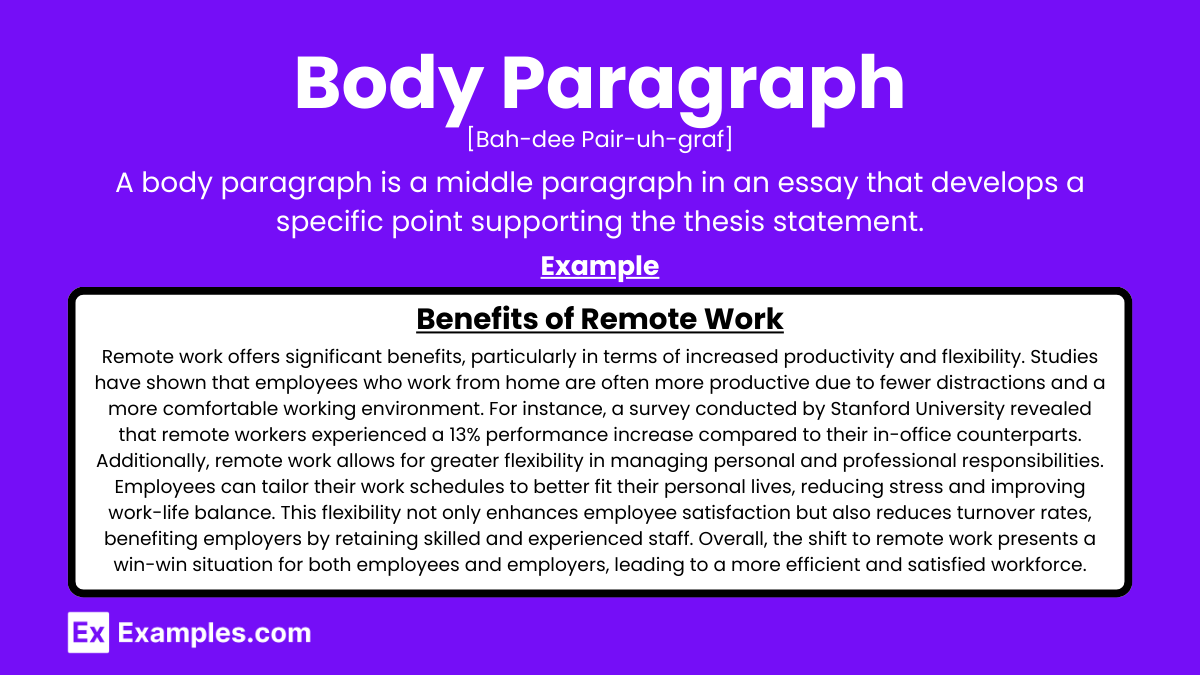25+ Body Paragraph Examples
Whether you’re crafting an essay, report, or any other form of written communication, the body paragraphs serve as the heart of your composition. They provide the substantive content that supports your main ideas, arguments, or points. Understanding how to construct compelling body paragraphs is essential for conveying your message effectively and persuasively. In this guide, we’ll delve into the definition of body paragraphs, explore the step-by-step process to create them, address common FAQs, and highlight their significance in written communication.
What is a Body Paragraph?
A body paragraph is a section of an essay that develops a single main idea, supported by evidence, examples, and explanations. Each body paragraph typically starts with a topic sentence, followed by supporting details, and concludes with a sentence that reinforces the paragraph’s main point or transitions to the next idea. Effective body paragraphs help to structure and advance the essay’s argument.
Body Paragraph Format
Body paragraphs form the core of an essay, providing the details and evidence that support the thesis statement. A well-structured body paragraph enhances clarity, flow, and persuasiveness in writing. Here’s a guide to constructing effective body paragraphs:
1. Topic Sentence
The topic sentence introduces the main idea of the paragraph. It should be clear, concise, and directly related to the thesis statement.
- Example: “Regular exercise significantly improves mental health.”
2. Explanation
Expand on the topic sentence by providing a brief explanation or elaboration. This helps to clarify the main idea and set up the evidence.
- Example: “Engaging in physical activities releases endorphins, which are natural mood lifters.”
3. Evidence
Present specific evidence to support the main idea. This can include quotes, statistics, examples, or research findings.
- Example: “A study by the Mayo Clinic found that participants who exercised regularly reported a 30% decrease in symptoms of depression and anxiety.”
4. Analysis
Analyze the evidence to show how it supports the topic sentence. Explain the significance and implications of the evidence.
- Example: “This decrease in mental health symptoms highlights the profound impact of physical activity on psychological well-being, suggesting that regular exercise can be an effective non-pharmaceutical treatment for mental health issues.”
5. Transition
Conclude the paragraph by linking back to the thesis or transitioning smoothly to the next paragraph. This helps maintain coherence and flow in the essay.
- Example: “Therefore, incorporating regular exercise into one’s routine can be a crucial step towards improving mental health. Next, we will explore the benefits of exercise on cognitive function.”
Examples of Body Paragraph for Essay
1. The Benefits of Reading
Reading regularly enhances cognitive functions. When individuals read, they engage multiple areas of the brain, improving neural connectivity. A study by the University of California found that regular readers exhibit higher levels of brain activity, particularly in areas related to language comprehension and analytical thinking. This increased brain activity suggests that reading not only improves comprehension skills but also enhances critical thinking and problem-solving abilities. Moreover, reading has been linked to a reduced risk of cognitive decline in older adults, further highlighting its long-term benefits. Therefore, incorporating reading into daily routines can significantly boost cognitive health and preserve mental sharpness over time.
2. The Impact of Technology on Education
Technology has revolutionized education by providing greater access to information and resources. With the advent of the internet and digital tools, students can access a vast array of educational materials from anywhere in the world. According to a report by the Pew Research Center, 92% of teachers reported that the internet has a major impact on their ability to access content, resources, and materials for their teaching. This accessibility not only enhances the learning experience but also enables personalized learning, where students can learn at their own pace and according to their interests. Furthermore, educational technologies such as online courses and virtual classrooms have made education more inclusive, reaching students in remote and underserved areas. Consequently, the integration of technology in education has democratized learning, making it more accessible and tailored to individual needs.
3. The Importance of Environmental Conservation
Environmental conservation is crucial for sustaining biodiversity and ensuring the health of our planet. Ecosystems are interdependent, and the loss of one species can have a ripple effect on others. For instance, the decline of bee populations, which are vital pollinators, has significant implications for plant reproduction and agricultural productivity. According to the Food and Agriculture Organization (FAO), 75% of the world’s food crops depend, at least in part, on pollination by bees and other insects. This interdependence underscores the importance of protecting species to maintain ecological balance and food security. Additionally, conserving natural habitats helps mitigate climate change by preserving forests that act as carbon sinks. Therefore, concerted efforts in environmental conservation are essential for the well-being of all life forms on Earth and the stability of our ecosystems.
4. The Advantages of Learning a Second Language
Learning a second language enhances cognitive abilities and cultural understanding. Bilingual individuals often exhibit improved memory, problem-solving skills, and multitasking abilities. Research from Pennsylvania State University indicates that bilingualism can delay the onset of Alzheimer’s disease by up to five years. This cognitive boost is attributed to the mental exercise of switching between languages and processing complex linguistic structures. Moreover, learning a new language fosters cultural empathy and global awareness. It allows individuals to better understand and appreciate cultural differences, promoting tolerance and reducing prejudice. In an increasingly interconnected world, these skills are invaluable, making bilingualism a significant asset both personally and professionally.
5. The Role of Physical Exercise in Health
Physical exercise plays a pivotal role in maintaining overall health and well-being. Regular physical activity helps control weight, reduce the risk of chronic diseases, and improve mental health. The Centers for Disease Control and Prevention (CDC) states that adults who engage in moderate-intensity exercise for at least 150 minutes per week lower their risk of heart disease, stroke, and diabetes. Additionally, exercise promotes the release of endorphins, which are natural mood lifters, reducing symptoms of depression and anxiety. Engaging in physical activities also enhances sleep quality, boosts energy levels, and improves muscle and bone strength. Consequently, incorporating regular exercise into one’s lifestyle is essential for physical and mental health, leading to a better quality of life.
Examples of Body Paragraph for Argumentative Essay
1. The Case for Universal Healthcare
Universal healthcare is essential for ensuring that all citizens have access to necessary medical services. In countries with universal healthcare, individuals do not have to worry about the financial burden of medical expenses, which can lead to better overall public health outcomes. For instance, a study conducted by the Commonwealth Fund found that countries with universal healthcare systems, such as Canada and the United Kingdom, have higher life expectancy and lower infant mortality rates compared to the United States. This data suggests that when people have access to healthcare without financial barriers, they are more likely to seek preventive care and treatment for illnesses, leading to healthier populations. Moreover, universal healthcare can reduce economic inequality by alleviating the financial strain on low-income families who might otherwise be unable to afford medical care. Therefore, implementing a universal healthcare system is a necessary step towards a healthier, more equitable society.
2. The Need for Renewable Energy
Investing in renewable energy sources is crucial for combating climate change and ensuring sustainable development. Fossil fuels, such as coal and oil, contribute significantly to greenhouse gas emissions, which are the primary drivers of global warming. According to the Intergovernmental Panel on Climate Change (IPCC), renewable energy sources like wind, solar, and hydropower produce little to no greenhouse gases during operation. This makes them a much cleaner alternative to traditional energy sources. Additionally, the renewable energy sector has the potential to create millions of jobs worldwide. The International Renewable Energy Agency (IRENA) reports that the renewable energy industry employed over 11 million people globally in 2018, a number that is expected to grow as investment in this sector increases. By transitioning to renewable energy, we can significantly reduce our carbon footprint while also fostering economic growth and job creation. Therefore, prioritizing renewable energy investments is imperative for a sustainable future.
3. The Benefits of Online Education
Online education provides greater accessibility and flexibility for students, making it an invaluable tool in modern education. Traditional classroom settings can be restrictive for individuals who have other commitments such as work or family. A report by the National Center for Education Statistics (NCES) shows that the number of students enrolled in at least one online course has steadily increased over the past decade, reaching over 6 million in the United States alone. This rise in online education enrollment demonstrates its growing popularity and effectiveness. Furthermore, online education allows for a personalized learning experience where students can learn at their own pace and revisit material as needed. Studies from the U.S. Department of Education suggest that students in online learning conditions performed modestly better, on average, than those receiving face-to-face instruction. Therefore, embracing online education can enhance learning opportunities and outcomes for a diverse range of students.
4. The Importance of Animal Testing in Medical Research
Animal testing remains a necessary practice for advancing medical research and ensuring the safety of new treatments. Many medical breakthroughs, including vaccines and life-saving treatments, have been developed through research conducted on animals. For instance, the polio vaccine, which has nearly eradicated the disease globally, was developed through extensive animal testing. Without such testing, it would have been impossible to ensure the vaccine’s effectiveness and safety. Moreover, regulatory agencies like the Food and Drug Administration (FDA) require animal testing to evaluate the safety of new drugs before they can be approved for human trials. This process helps protect human participants from potential adverse effects. While it is crucial to continue seeking alternative methods, current scientific capabilities still rely on animal testing to a significant extent. Therefore, until reliable and effective alternatives are found, animal testing remains an essential component of medical research.
5. The Impact of Social Media on Society
Social media has a profound impact on society, influencing everything from communication to mental health. Platforms like Facebook, Twitter, and Instagram have revolutionized the way people interact, share information, and stay connected. However, research indicates that excessive use of social media can lead to negative mental health outcomes. A study published in the Journal of Social and Clinical Psychology found that individuals who limited their social media use to 30 minutes per day reported significant reductions in feelings of loneliness and depression. This suggests that while social media can facilitate connection, overuse can exacerbate feelings of isolation and anxiety. Additionally, the spread of misinformation on social media platforms poses a significant threat to public discourse and democratic processes. Therefore, it is essential to promote responsible use of social media and implement measures to combat misinformation to mitigate its negative impacts on society.
Examples of Body Paragraph for Informative Essay
1. The History of the Internet
The internet has a rich history that dates back to the early days of computer networking. The concept of a global network began in the 1960s with the creation of ARPANET, funded by the United States Department of Defense. ARPANET, which stands for Advanced Research Projects Agency Network, was the first network to implement the TCP/IP protocol suite, which became the foundation of the modern internet. In the 1980s, the development of personal computers and the World Wide Web, invented by Tim Berners-Lee in 1989, revolutionized how information was shared and accessed. The introduction of web browsers, like Mosaic and Netscape, in the early 1990s made the internet more user-friendly and accessible to the general public. This period marked the beginning of the internet’s rapid expansion and integration into everyday life, leading to the interconnected digital world we experience today.
2. The Benefits of a Balanced Diet
A balanced diet is essential for maintaining good health and well-being. Consuming a variety of foods ensures that the body receives the necessary nutrients it needs to function properly. For example, fruits and vegetables are rich in vitamins and minerals, which support immune function and reduce the risk of chronic diseases. Protein-rich foods, such as lean meats, beans, and nuts, are crucial for muscle repair and growth, while whole grains provide sustained energy and help regulate blood sugar levels. According to the Harvard T.H. Chan School of Public Health, a balanced diet that includes a wide range of nutrients can improve overall health and reduce the risk of conditions like heart disease, diabetes, and obesity. Furthermore, staying hydrated by drinking plenty of water is also a key component of a balanced diet, as it aids digestion and helps maintain body temperature. Therefore, incorporating a variety of nutrient-rich foods into one’s diet is fundamental to achieving and maintaining optimal health.
3. The Role of Technology in Modern Education
Technology plays a pivotal role in modern education, transforming the way students learn and teachers instruct. With the advent of digital tools and online resources, educational opportunities have expanded significantly. For instance, interactive software and applications make learning more engaging and personalized, catering to individual student needs. According to a report by the National Education Association (NEA), technology in the classroom has been shown to improve student motivation and academic performance. Moreover, online learning platforms, such as Coursera and Khan Academy, provide access to a vast array of courses and educational materials, enabling lifelong learning beyond the traditional classroom setting. These resources allow students to learn at their own pace and revisit difficult concepts as needed. Consequently, the integration of technology in education not only enhances learning experiences but also prepares students for a digital future.
4. The Importance of Environmental Conservation
Environmental conservation is crucial for preserving the planet’s biodiversity and natural resources. Human activities, such as deforestation, pollution, and overfishing, have led to significant environmental degradation. For example, the destruction of rainforests not only results in the loss of countless species but also contributes to climate change by reducing the Earth’s capacity to absorb carbon dioxide. The World Wildlife Fund (WWF) reports that approximately 27% of the Amazon rainforest has been destroyed in the past 50 years, posing a severe threat to global biodiversity. Conservation efforts, such as protecting natural habitats, promoting sustainable practices, and reducing carbon emissions, are essential to mitigate these impacts. By implementing and supporting conservation initiatives, we can help ensure that natural ecosystems remain intact for future generations. Therefore, environmental conservation is a responsibility that must be shared by individuals, communities, and governments worldwide.
5. The Advantages of Learning a Second Language
Learning a second language offers numerous cognitive, social, and professional benefits. Research indicates that bilingual individuals often have better cognitive flexibility, which is the ability to switch between tasks and think about multiple concepts simultaneously. A study published in the journal Psychological Science found that bilingualism can enhance executive function, which includes skills such as problem-solving, memory, and attention control. In addition to cognitive advantages, knowing a second language can improve cultural awareness and communication skills. This is particularly valuable in today’s globalized world, where cross-cultural interactions are common. Professionally, bilingualism can open up job opportunities and enhance career prospects in various fields, such as international business, translation, and diplomacy. Therefore, investing time and effort in learning a second language can yield significant personal and professional rewards.
Examples of Body Paragraph for Research Paper
1. The Effects of Climate Change on Polar Bear Populations
Climate change has significantly impacted polar bear populations, primarily through the loss of their sea ice habitat. Polar bears rely on sea ice as a platform for hunting seals, their primary food source. According to a study by the National Snow and Ice Data Center (NSIDC), the Arctic sea ice extent has declined by approximately 13% per decade since the late 1970s. This reduction in sea ice forces polar bears to travel greater distances and expend more energy to find food, leading to malnutrition and decreased survival rates, especially among cubs. Moreover, a report by the World Wildlife Fund (WWF) indicates that the shrinking ice habitat also increases the likelihood of human-polar bear conflicts as bears venture closer to human settlements in search of food. These findings underscore the urgent need for comprehensive climate policies to mitigate the effects of global warming and protect polar bear populations.
2. The Role of Artificial Intelligence in Healthcare
Artificial intelligence (AI) has revolutionized healthcare by enhancing diagnostic accuracy and improving patient outcomes. AI algorithms can analyze vast amounts of medical data, identifying patterns that may not be evident to human clinicians. For instance, a study published in Nature Medicine demonstrated that an AI system could diagnose skin cancer with greater accuracy than dermatologists, achieving a sensitivity rate of 95% compared to 86.6% for human experts. This capability allows for earlier detection and treatment of diseases, potentially saving lives. Additionally, AI-driven predictive analytics can help in managing chronic conditions by forecasting disease progression and suggesting personalized treatment plans. According to a report by Accenture, AI applications in healthcare could save the U.S. healthcare economy up to $150 billion annually by 2026 through efficiencies and improved outcomes. These advancements highlight the transformative potential of AI in making healthcare more efficient, accurate, and accessible.
3. The Impact of Social Media on Political Polarization
Social media has played a significant role in exacerbating political polarization by creating echo chambers and facilitating the spread of misinformation. Algorithms on platforms like Facebook and Twitter often promote content that aligns with users’ existing beliefs, reinforcing their viewpoints and isolating them from opposing perspectives. A study by the Pew Research Center found that 62% of Americans get their news from social media, where they are more likely to encounter sensationalized and biased information. This selective exposure can deepen ideological divides and reduce the likelihood of constructive political discourse. Moreover, research published in Science revealed that false news stories on social media spread six times faster than true stories, further fueling division and mistrust. These findings indicate that social media not only mirrors but also amplifies societal divisions, necessitating interventions to promote media literacy and responsible content sharing.
4. The Benefits of Bilingual Education Programs
Bilingual education programs offer significant cognitive and academic benefits to students. Studies have shown that bilingual individuals possess enhanced executive function, which includes skills such as problem-solving, multitasking, and memory. For example, research conducted by the American Psychological Association (APA) indicates that bilingual children outperform monolingual peers in tasks that require switching attention and inhibiting distractions. These cognitive advantages translate into academic success, with bilingual students often achieving higher scores in standardized tests. Additionally, a longitudinal study by the University of California, Los Angeles (UCLA) found that students enrolled in dual-language programs were more likely to graduate high school and attend college compared to their monolingual counterparts. These outcomes suggest that bilingual education not only supports cognitive development but also enhances long-term educational achievement. Therefore, expanding access to bilingual programs can provide substantial benefits to students and society as a whole.
5. The Economic Impact of Renewable Energy Adoption
Adopting renewable energy sources has significant positive impacts on the economy, including job creation and energy security. The transition to renewable energy requires a substantial workforce to manufacture, install, and maintain technologies such as solar panels and wind turbines. According to the International Renewable Energy Agency (IRENA), the renewable energy sector employed over 11 million people globally in 2018, with job numbers expected to rise as investment in this sector increases. This job creation can stimulate economic growth, particularly in regions struggling with unemployment. Furthermore, renewable energy reduces dependence on imported fuels, enhancing national energy security and price stability. A report by the U.S. Department of Energy highlights that increased use of domestic renewable energy sources can protect the economy from fluctuations in global fossil fuel markets. Thus, the economic benefits of renewable energy adoption extend beyond environmental considerations, offering substantial advantages for employment and national security.
Examples of Body Paragraph for Students
1. The Importance of Time Management for Students
Effective time management is crucial for students to achieve academic success and maintain a healthy work-life balance. Properly managing time allows students to prioritize tasks, ensuring that important assignments and study sessions are completed efficiently. For instance, a study by the University of California, Berkeley found that students who practiced time management techniques, such as using planners and setting specific goals, achieved higher grades and reported lower stress levels. By breaking down larger tasks into smaller, manageable steps, students can avoid last-minute cramming and reduce anxiety. Moreover, time management skills are not only beneficial for academic purposes but also for extracurricular activities and personal life. Students who balance their schedules effectively can participate in sports, hobbies, and social events, contributing to their overall well-being and personal development. Therefore, mastering time management is essential for students to succeed academically and enjoy a balanced lifestyle.
2. The Benefits of Extracurricular Activities
Participating in extracurricular activities offers numerous benefits that enhance students’ educational experiences and personal growth. Engaging in activities such as sports, clubs, and arts programs helps students develop essential skills that are not typically taught in the classroom. For example, involvement in team sports teaches valuable lessons in teamwork, leadership, and perseverance. According to a report by the National Center for Education Statistics (NCES), students who participate in extracurricular activities are more likely to have higher academic achievement and better attendance records. These activities also provide opportunities for students to explore their interests and talents, which can influence their future career choices and aspirations. Additionally, extracurricular involvement fosters a sense of belonging and community, helping students build friendships and support networks. Thus, engaging in extracurricular activities is instrumental in promoting well-rounded development and enriching the overall educational experience for students.
3. The Impact of Nutrition on Academic Performance
Proper nutrition plays a vital role in students’ academic performance and overall health. Consuming a balanced diet that includes a variety of nutrients helps maintain energy levels, improve concentration, and enhance cognitive function. A study published in the Journal of School Health found that students who ate a nutritious breakfast performed better on standardized tests and had higher attendance rates compared to those who skipped breakfast. Healthy eating habits also contribute to better mood regulation and reduced stress, which are important for academic success. For instance, foods rich in omega-3 fatty acids, such as fish and flaxseeds, have been shown to support brain health and improve memory. Schools that implement nutrition education programs and provide healthy meal options can significantly impact students’ learning outcomes. Therefore, promoting proper nutrition is essential for students to achieve their full academic potential and maintain overall well-being.
4. The Advantages of Using Technology in the Classroom
Integrating technology into the classroom offers numerous advantages that enhance the learning experience for students. Digital tools and resources make learning more interactive and engaging, catering to different learning styles and needs. For instance, educational apps and online platforms allow students to practice skills at their own pace and receive immediate feedback. According to a report by the U.S. Department of Education, schools that utilize technology effectively see improvements in student motivation and achievement. Technology also facilitates access to a wealth of information and educational materials, enabling students to conduct research and expand their knowledge beyond the textbook. Furthermore, incorporating technology prepares students for the digital world, equipping them with essential skills for future careers. Thus, the use of technology in education not only enhances academic performance but also prepares students for success in a technologically advanced society.
5. The Importance of Reading for Pleasure
Reading for pleasure is an important habit that benefits students academically and personally. Engaging in recreational reading improves literacy skills, vocabulary, and comprehension. A study by the National Literacy Trust found that students who read for enjoyment are more likely to perform better academically, particularly in language and literacy subjects. Additionally, reading for pleasure enhances creativity and imagination, allowing students to explore new ideas and perspectives. For example, reading fiction can increase empathy by helping students understand and relate to characters’ experiences and emotions. Beyond academic benefits, reading provides a relaxing escape from the pressures of school and daily life, promoting mental well-being. Therefore, encouraging students to read for pleasure is essential for their overall development and success.
More Examples & Samples of Body Paragraph in PDF
1. Developing Body Paragraphs Example
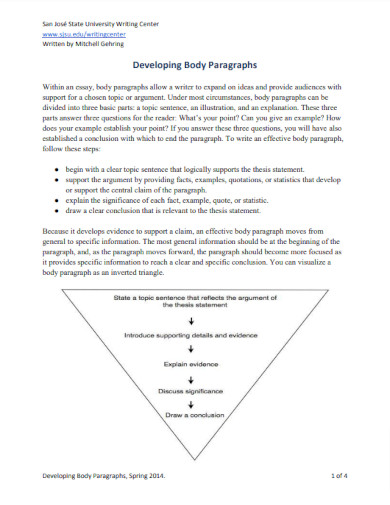
sjsu.edu
2. Strong Body Paragraphs Example
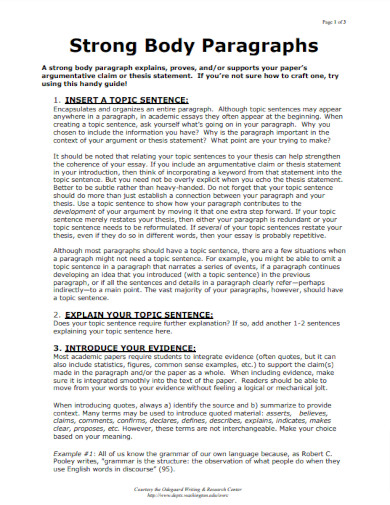
depts.washington.edu
3. Body Paragraph Structure and Development
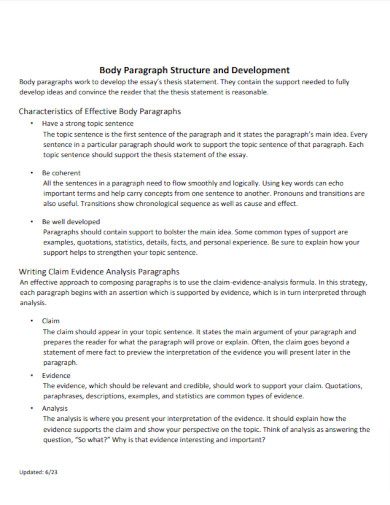
ivcc.edu
4. Basic Body Paragraphs Example
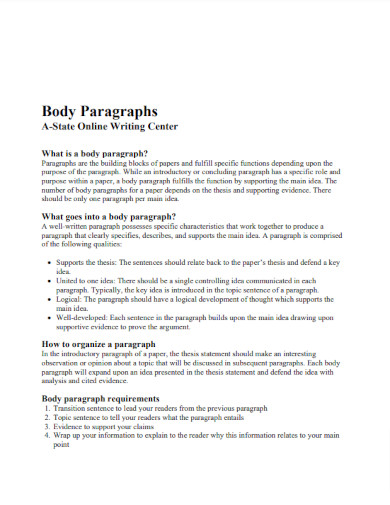
astate.edu
5. How to Write Body Paragraphs Example
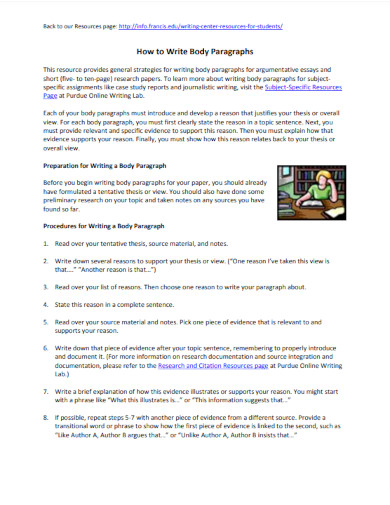
my.francis.edu
6. Purpose of a Body Paragraph Example
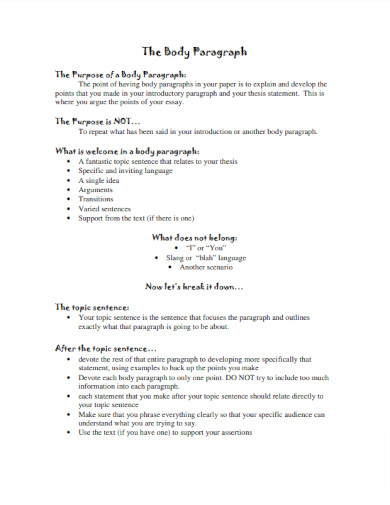
dvusd.org
Parts of a Body Paragraph
A well-constructed body paragraph is essential for a coherent and persuasive essay. Each body paragraph should support the main thesis of the essay and contribute to the overall argument or analysis. Here are the key parts of a body paragraph:
1. Topic Sentence
The topic sentence introduces the main idea of the paragraph. It should be clear, concise, and directly related to the thesis statement of the essay.
- Example: “Effective time management is crucial for students to achieve academic success.”
2. Explanation
The explanation elaborates on the topic sentence, providing context or a brief overview of the main idea. It sets up the evidence and analysis that will follow.
- Example: “Properly managing time allows students to prioritize tasks, ensuring that important assignments and study sessions are completed efficiently.”
3. Evidence
Evidence provides specific support for the main idea. This can include quotes, statistics, examples, or research findings. Evidence makes the argument more credible and persuasive.
- Example: “A study by the University of California, Berkeley found that students who practiced time management techniques, such as using planners and setting specific goals, achieved higher grades and reported lower stress levels.”
4. Analysis
The analysis explains how the evidence supports the topic sentence. It connects the evidence to the main idea and shows the significance or implications of the evidence.
- Example: “By breaking down larger tasks into smaller, manageable steps, students can avoid last-minute cramming and reduce anxiety, leading to better academic performance.”
5. Transition or Concluding Sentence
The transition or concluding sentence links back to the thesis or sets up the next paragraph. It ensures coherence and flow in the essay.
- Example: “Therefore, mastering time management is essential for students to succeed academically and enjoy a balanced lifestyle.”
How to Start a Body Paragraph
Starting a body paragraph effectively is essential for maintaining coherence and ensuring that each paragraph contributes meaningfully to the essay. Here are key steps and tips for starting a body paragraph:
1. Craft a Strong Topic Sentence
The topic sentence is the most important part of the body paragraph. It introduces the main idea of the paragraph and ties it to the thesis statement.
- Example: “Implementing renewable energy sources is essential for reducing greenhouse gas emissions.”
2. Connect to the Thesis Statement
Ensure that the topic sentence clearly relates to and supports the essay’s thesis statement. This connection helps maintain the overall coherence of the essay.
- Example: “Given the urgent need to address climate change, implementing renewable energy sources is essential for reducing greenhouse gas emissions.”
3. Use Transition Words or Phrases
If the paragraph follows another body paragraph, use transition words or phrases to create a smooth flow of ideas. This helps guide the reader through the argument or analysis.
- Example: “Moreover, implementing renewable energy sources is essential for reducing greenhouse gas emissions.”
4. Introduce the Main Idea Clearly
State the main idea in a way that is easy to understand and sets up the explanation and evidence that will follow.
- Example: “Implementing renewable energy sources is essential for reducing greenhouse gas emissions, as it offers a sustainable alternative to fossil fuels.”
How to End a Body Paragraph
Ending a body paragraph effectively is crucial for maintaining the flow and coherence of your essay. A strong concluding sentence can reinforce your main point, connect to the thesis, and provide a smooth transition to the next paragraph. Here are key steps and tips for ending a body paragraph:
1. Summarize the Main Point
Briefly restate the main idea of the paragraph without repeating it verbatim. This reinforces the point you’ve made.
- Example: “Therefore, renewable energy sources are essential for reducing greenhouse gas emissions.”
2. Connect to the Thesis
Ensure that the concluding sentence links back to the thesis statement, reinforcing how the paragraph supports the overall argument.
- Example: “This reduction in emissions is a critical step in combating climate change, aligning with the global effort to create a more sustainable future.”
3. Provide a Transition
Use a transitional phrase or sentence to smoothly lead into the next paragraph. This helps maintain coherence and guides the reader through your essay.
- Example: “As we explore further, the economic benefits of renewable energy adoption also become apparent.”
4. Avoid Introducing New Information
Do not introduce new arguments or evidence in the concluding sentence. The focus should be on wrapping up the current paragraph and preparing for the next one.
How to Write a Body Paragraph
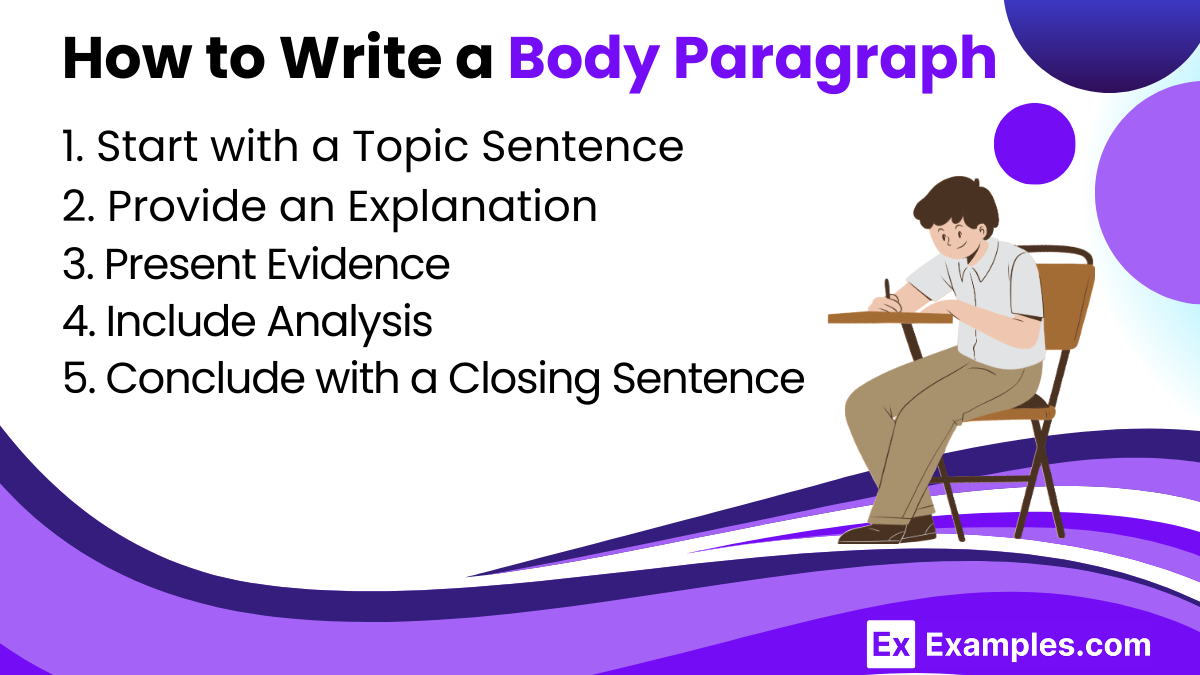
1. Start with a Topic Sentence
- Purpose: Introduce the main idea of the paragraph.
- Example: “One of the most significant advantages of renewable energy is its positive impact on the environment.”
2. Provide an Explanation
- Purpose: Clarify the topic sentence and provide context.
- Example: “Renewable energy sources, such as solar and wind power, produce little to no greenhouse gas emissions during their operation.”
3. Present Evidence
- Purpose: Support the main idea with relevant data, quotes, or examples.
- Example: “According to a 2020 report by the International Energy Agency, solar power capacity grew by 22% worldwide, reducing CO2 emissions by approximately 1.2 billion tons annually.”
4. Include Analysis
- Purpose: Explain how the evidence supports the main idea.
- Example: “This significant reduction in emissions highlights how transitioning to renewable energy sources can mitigate climate change, a pressing global issue.”
5. Conclude with a Closing Sentence
- Purpose: Summarize the paragraph’s main point and transition to the next paragraph.
- Example: “Therefore, the shift to renewable energy is not only beneficial for reducing environmental harm but also essential for sustainable development.”
How long should a body paragraph be?
A body paragraph typically ranges from 5-8 sentences or 150-200 words, balancing detail and clarity without overwhelming the reader.
What is the purpose of a topic sentence?
A topic sentence introduces the main idea of the paragraph and sets the tone for the content that follows.
How can I ensure coherence in my body paragraph?
Use transitional words and phrases, maintain a logical flow of ideas, and ensure all sentences relate to the main idea.
What types of evidence can I use?
Use facts, statistics, quotes, examples, and anecdotes from credible sources to support your main idea effectively.
Why is analysis important in a body paragraph?
Analysis explains how your evidence supports your main idea, demonstrating critical thinking and deepening the reader’s understanding.
How do I transition between body paragraphs?
Use transitional sentences or phrases that connect the ideas of consecutive paragraphs, maintaining a smooth flow throughout your essay.
What should a closing sentence do?
A closing sentence should summarize the paragraph’s main point and provide a transition to the next paragraph.
Can I use personal experiences as evidence?
Yes, personal anecdotes can be powerful evidence, especially in narrative or persuasive essays, if they are relevant and support your point.
How many body paragraphs should an essay have?
The number of body paragraphs depends on the essay’s length and complexity, but typically ranges from 3-5 for standard essays.
What common mistakes should I avoid in body paragraphs?
Avoid vague topic sentences, lack of evidence, poor transitions, and irrelevant details that do not support the main idea.



